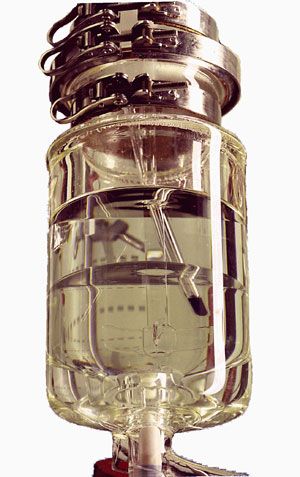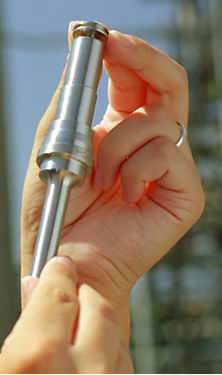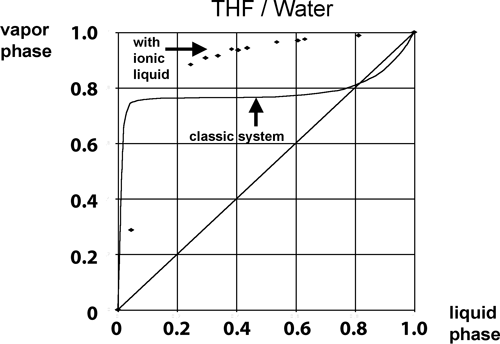Ionic Liquids in the Chemical Synthesis of Pharmaceuticals
PTSM: Pharmaceutical Technology Sourcing and Management
Ionic liquids provide an alternative to certain solvents in select reactions used to synthesize intermediates and active pharmaceutical ingredients.
Although their physical and chemical properties seem unusual, ionic liquids are simply molten salts with melting points below 100 °C, not far from room temperature. With this technology, a liquid is available that consists entirely of ions making it different from all other “conventional” liquids. Most people are familiar with liquids that are neutral such as water or solvents such as ethanol or toluene. This relatively new class of chemicals with unique properties offers some very exciting opportunities in synthesis and chemical processing.
The physical and chemical properties of ionic liquids can be expected to be very different from those of typical “neutral” liquids. When ionic liquids were first studied extensively and articles published in the late 1990s, this small, but important difference, triggered huge interest and excitement in the academic world. Within a short time of their discovery, ionic liquids received enormous attention by academic and industrial communities. Mainly chemists pioneered work with these new materials (1). Their hope was that the ionic nature of ionic liquids would drastically change speed and selectivity of a variety of chemical reactions. Extensive work has been carried out in the past few years, which is probably best summarized in a book (Ionic Liquids in Synthesis) by Wasserscheid and Welton for which a second extended edition has been published (2).
The key properties that set ionic liquids apart from other liquids include the following:
• Existing as molten salts, in many cases even below room temperature
• Highly polar
• Often immiscible with organic solvents
• Literally no vapor pressure
• Nonflammable
• Large liquidus range (typically > 300 °C grade)
• Electrically conducting
• Remarkable dissolution properties (e.g., wood, cellulose, polyamides)
• High thermostability.
Commercial applications of ionic liquids
The first commercial and large-scale application of ionic liquids was accomplished and reported by BASF in 2004 (3–9). The BASF “BASIL” process (i.e., BASIL is Biphasic Acid Scavenging utilizing Ionic Liquids) was introduced for the synthesis of alkoxyphenylphosphines, which are important raw materials for photoinitiators. HCl is formed during the synthesis of diethoxyphenylphosphine (see Figure 1).

Figure 1: The synthesis of diethoxyphenylphosphine. Figure courtesy of BASF SE.
Scavenging with conventional tertiary amines results in a thick, nonstirable slurry that leads to lower yields and capacities because of insufficient mixing and heat transfer. The idea of BASF researchers was to use an ionic liquid precursor as an acid scavenger. This concept turned out to be successful with 1-methylimidazole. After the reaction with HCl, an ionic liquid is formed: 1-methyl-imidazolium chloride (Hmim Cl), which is a liquid at reaction temperature. Therefore, during the reaction, two clear liquid phases occur (see Figure 2) that can easily be separated. The upper phase is the pure product (no solvent is needed anymore); the lower phase is the pure ionic liquid. Hmim Cl can be switched on and off through simple protonation and deprotonation. This property is crucial for recycling and purification of the ionic liquids.

Figure 2: The BASIL process. After the reaction, two clear liquid phases are obtained: the upper phase is the pure product, and the lower phase is the ionic liquid 1-methyl-imidazolium chloride (Hmim Cl). Figure courtesy of BASF SE.
The advantage of this process setup is even greater as 1-methylimidazole also acts as a nucleophilic catalyst with completion of the phosphorylation reaction in less than 1 s (10). Now, having eliminated the formation of solids and increased the reaction rate, new reactor concepts were possible. Instead of using a large vessel, the reaction could be carried out in a tiny jet reactor with the size of a human thumb (see Figure 3). Doing so, the process productivity could be increased by a factor of 8 x 104 to 690,000 kg m-3 h-1. At the end of 2004, BASF successfully started a dedicated BASIL plant using this jet-stream reactor technology.

Figure 3: The BASIL process is run in a small jet reactor that has a capacity of 690,000 kg m-3 h-1. Figure courtesy of BASF SE.
In addition, the new process offers advantages in eco-efficiency. Recently, it was shown that the BASIL technology is by far more sustainable than the process using tertiary amines (11).
Further investigations revealed that BASIL is not restricted to phosphorylation chemistry but is a general solution to all kinds of acid-scavenging needs (3–9). Acylations and silylations have been investigated successfully as well as an elimination reaction. BASIL is also applicable to extractive acid removal from organic phases such as for the purpose of purification.
Other applications of ionic liquids
Applying ionic liquids in chemical reactions is not limited to acid scavenging. A strong effect of ionic liquids can be expected for all reactions with dipolar transition states. Many reactions have been studied, including:
• Nucleophilic and electrophilic substitution/addition
• Acid catalysis, Friedel–Crafts–catalysis
• Nitration
• Halogenation
• Diels–Alder and “ene” eeactions
• Esterification
• Michael additions
• Mannich reactions
• Oxidation and epoxidation (2).
Nevertheless, in a number of cases, the advantages of running the reaction in an ionic liquid compared with a classical solvent were small, not meeting anticipated high expectations or justifying extra expense. There are examples, however, as in the BASIL process, where ionic liquids offer valuable advantages. In those cases, there is a combination of improved speed or selectivity and advantages in chemical processing. There are four classes of chemical reactions where advantages are evident:
• Nucleophilic substitutions
• Acid and Friedel–Crafts–catalysis
• High-temperature reactions (e.g., Rearrangement reactions, Diels–Alder, Heck couplings)
• Oxidation and epoxidation
Nucleophilic substitutions. For nucleophilic substitutions, BASF surprisingly found that chlorination of alcohols can be achieved with high yields ( > 98% just by using HCl gas if carried out in an ionic liquid (12). This reaction is typically done with phosgene, SOCl2, PCl3 or PCl5 in order to achieve sufficient conversion and selectivity. Ionic liquids are by far the superior solvent for these reactions because ether byproducts, which typically are the dead-ends of the reaction in classic solvents, are further cleaved in the ionic environment. This condition is supported by a publication from researchers at Eli Lilly who describe the demethylation of the usually very difficult to cleave aromatic methoxy ethers by using HCl in an ionic liquid (13).
Acid catalysis. In the field of acid catalysis, the advantages of ionic liquids arise from the use of nonvolatile, liquid, and easy-to-separate catalysts. Moreover, very remarkable physicochemical properties can be achieved. One example is super acidity. With the system 1-ethyl-3-methyl-imidazolium (EMIM) Al2Cl7 • HCl, H0-values on the Hammett acidity scale of approximately –15 can be achieved, which is comparable to the acidity of liquid HF (14–15). For comparison, 100% sulfuric acid has a H0 of –12.3, and 100% trifluoromethansulfonic acid has a H0 of –14.1.
The superacidity is caused by the following equilibrium (see Figure 4) (14-15):

Figure 4: Equilibrium of the 1-ethyl-3-methyl-imidazolium (EMIM) Al2Cl7 • HCl. Figure courtesy of BASF SE
Al2Cl7 absorbs the chloride anion of HCl gas so efficiently that a “naked“ superacidic proton is left over.
High-temperature reactions. For high-temperature reactions, the advantage of ionic liquids as solvents is their high thermostability and nonvolatility. In many ionic liquids, reactions can be carried out in standard equipment at temperatures above 200 °C without the use of autoclaves.
Oxidation chemistry. A fourth very attractive field for ionic liquids is oxidation chemistry where suitable stable classical organic solvents are typically hard to find.
Ionic liquids in separation technologies.
Ionic liquids offer a huge potential in separation technology. They have, for example, the ability to break azeotropes and act as so-called entrainers (16-18). Many classical azeotropes such as ethanol/water or tetrohydrofuran/water can be broken by adding ionic liquids to the mixture as shown in Figure 5.

Figure 5: Equilibrium-phase diagram for the system of tetrahydrofuran (THF)/water. The solid line shows the classic azeotropic mixture. The dots indicate how the azeotrope has been broken after addition of the ionic liquid. The amount of THF in the vapor phase is always larger than in the liquid phase. Units are in molfraction of THF. Figure courtesy of BASF SE.
The advantage of an ionic liquid over a classic entrainer is that ionic liquids have no vapor pressure. This property means that the entrainer itself does not need to be distilled. A second separation column is not needed, and energy can be saved. A benchmark calculation reveals a savings potential of roughly 37% for energy costs and 22% for investment in equipment. BASF has run an extractive distillation process in a pilot plant continuously for three months. Although the ionic liquid faced a severe thermal treatment of about 250 °C in the recycling step, its performance fully remained without any purge. This underlines the high thermal stability of ionic liquids, and that very high recycling rates are possible without a decrease in performance.
Ionic liquids also exhibit remarkable extraction properties in liquid-liquid extractions (19). One example is the removal of phenols from reaction mixtures. The classic way of doing this is an extraction with caustic, acidification, and re-extraction of the phenol with an organic solvent plus subsequent distillation. This process is a multistep procedure, which includes generation of a wastewater stream. If other components are sensitive to high pHs, even some product decomposition and loss of yield could occur. BASF has found that acidic ionic liquids such as EMIM HSO4 are very efficient extractants for phenols. More than 95% of the phenol has been removed from an organic solvent in one-step extraction and more than 99.8% in a two-step extraction. Other components sensitive under basic conditions are not affected by the acidic ionic liquid. Also, the recycling procedure for the ionic liquid is relatively easy. It is a one-step distillation of phenol from the ionic liquid. The nonvolatile ionic liquid is left at the bottom, whereas the phenol distills off and can be reused. This is just a one-step workup without generation of any wastewater stream.
Conclusion
The examples discussed in this article demonstrate that ionic liquids are no longer just laboratory curiosities, but have shown to bring commercial value in chemical synthesis and separation technology. They are available at large-scale quantities and can be handled successfully on an industrial scale in chemical processes.
References
1. M. Freemantle, “Designer Solvents: Ionic Liquids May Boost Clean Technology Development,” Chem. Eng. News 76 (13), 32–37 (1998).
2. P. Wasserscheid and T. Welton, Eds., Ionic Liquids in Synthesis, (Wiley-VCH, 2nd edition Weinheim, Germany, 2007).
3. BASF SE, “Method for the Separation of Acids from Chemical Reaction Mixtures by Means of Ionic Fluids," World Patent WO/2003/062171, Jul. 31, 2003.
4. BASF SE, “Method for the Separation of Acids from Chemical Reaction Mixtures by Means of Ionic Fluids,” World Patent WO/2003/062251, Jul. 31, 2003.
5. BASF SE, “Method for Isolating Acids from Chemical Reaction Mixtures by Using 1-Alkylimidazoles,” World Patent WO2005/061416, Jul. 7, 2005.
6. M. Maase, “Aus der Industrie Erstes technisches Verfahren mit ionischen Flüssigkeiten,” Chemie unserer Zeit, 38 (6) 434–435 (2004).
7. M. Freemantle, “BASF’s Smart Ionic Liquid,” Chem. Eng. News81 (13), 9 (2003).
8. K.R. Seddon, “Ionic liquids: A Taste of the Future,” Nature Mater. 2 (6) 363–365 (2003).
9. K.R. Seddon and R.D. Rogers, “Ionic Liquids: Solvents of the Future,” Science, 302 (5646) 792–793 (2003).
10. J. Chojnowski, M. Cypryk, and W. Fortuniak, “The Extension of the Mechanistic Concept of the Nucleophilic Catalysis in the Silicon Chemistry to Some Reactions of the P(III) center: Analogies between Silylation and Phosphorylation,” Heteroatom. Chem.2 (1), 63–70, 1991.
11. M. Maase, “An Improved Way of Doing It,” presented at the 1st International Congress on Ionic Liquids, Salzburg, Austria, Jun. 20, 2005.
12. BASF SE, “Method for Producing Haloalkanes From Alcohols,” World Patent WO/2005/026089, Mar. 24, 2005.
13. C.R. Schmid et al., “Demethylation of 4-Methoxyphenylbutyric Acid Using Molten Pyridinium Hydrochloride on Multikilogram Scale,” Org. Proc. Res. Dev8 (4), 670–673 (2004).
14. G.P. Smith et. al. “Broensted Superacidity of Hydrochloric Acid in a Liquid Chloroaluminate: Aluminum Chloride-1-ethyl-3-methyl-1H-imidazolium Chloride (55.O m/o AlCl3), J. Am. Chem. Soc., 111 (2), 525–530 (1989).
15. G.P. Smith et al., “Quantitative Study of the Acidity of Hydrogen Chloride in a Molten Chloroaluminate System (Aluminum Chloride/1-ethyl-3-methyl-1H-imidazolium chloride) as a function of HCl Pressure and Melt composition (51.0–66.4 mol% AlCl3), J. Am. Chem. Soc., 111 (14), 5075–5077 (1989).
16. BASF SE, “Ionic Liquids as Selective Additives for the Separation of Close-Boiling or Azeotropic Mixtures,” World Patent WO/2002 02/074718, Sept. 26, 2002.
17. C. Jork et al., “Influence of Ionic Liquids on the Phase Behavior of Aqueous Azeotropic Systems,” J. Chem. Eng. Data,49 (4), 852–857 (2004).
18. BASF SE, “Ionic Liquids as Selective Additives for the Separation of Close-Boiling or Azeotropic Mixtures,” World Patent WO/2005/016484, Sept. 26, 2002.
19. BASF SE, “Method for Extracting Impurities Using Ionic Liquids,” World Patent WO/2005/019137, Mar. 3, 2005.
Matthias Maase, PhD, is with new business development for intermediates at BASF in North America.
Drug Solutions Podcast: A Closer Look at mRNA in Oncology and Vaccines
April 30th 2024In this episode fo the Drug Solutions Podcast, etherna’s vice-president of Technology and Innovation, Stefaan De Koker, discusses the merits and challenges of using mRNA as the foundation for therapeutics in oncology as well as for vaccines.
PacBio Chosen as Tech Partner for Global Alzheimer’s Disease Research Project
April 23rd 2025The project, the North African Dementia Registry, will unite multiple entities for the purpose of developing a comprehensive dataset to advance the research community’s understanding of Alzheimer’s disease and other dementias in diverse populations.